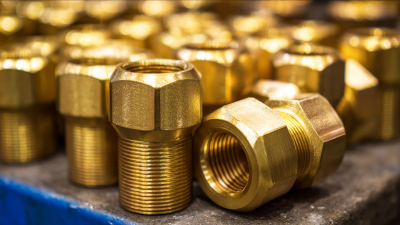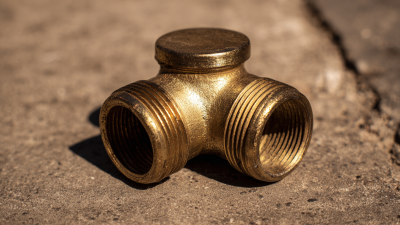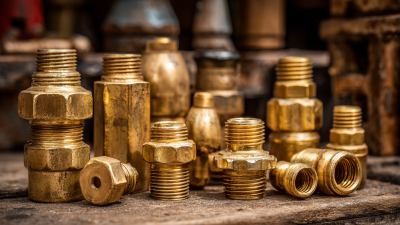How to Choose the Best Brass Elbow for Your Plumbing Needs
When it comes to plumbing, choosing the right fittings is crucial for ensuring a reliable and efficient system. One of the key components in plumbing systems is the Brass Elbow, which plays a vital role in connecting pipes and facilitating smooth directional changes. However, with a variety of types and styles available in the market, selecting the best Brass Elbow for your specific needs can be a daunting task. Understanding the different types, such as 90-degree, 45-degree, or reducing elbows, as well as their materials and finishes, is essential for making an informed decision. In this blog, we will delve into the factors to consider when selecting a Brass Elbow, ensuring you can make the best choice for your plumbing projects, enhance durability, and prevent potential leaks in the long run.

Understanding Different Types of Brass Elbows for Plumbing Applications
When it comes to plumbing applications, selecting the right brass elbow is crucial for ensuring efficiency and longevity in your system. Brass elbows come in various types, each designed for specific purposes. The most common types you will encounter include 90-degree elbows, 45-degree elbows, and teed elbows. A 90-degree elbow is ideal for changing the direction of the piping system at sharp angles, often used in corners or tight spaces. On the other hand, a 45-degree elbow offers a gentler transition, which can help minimize flow resistance and reduce wear on your plumbing over time.
Understanding the different finishes and thread types of brass elbows is also vital. Some elbows are designed with threaded ends for easy connection to various fittings, while others feature solder joints for a more permanent installation. Additionally, the finish on the brass can impact the elbow's resistance to corrosion and overall performance. Choosing between polished and unpolished finishes can depend on the specific environment in which the elbows will be installed. By familiarizing yourself with these variations, you can make an informed decision that aligns with your plumbing needs, ensuring optimal performance and durability in your piping system.
Key Factors to Consider When Selecting a Brass Elbow
When selecting a brass elbow for your plumbing needs, several key factors must be considered to ensure durability and functionality. First, you should pay attention to the types of brass used in the elbow fittings. Studies have shown that components made from C36000 brass, known for its high corrosion resistance, can last up to 20% longer in water applications than those made from lower-grade brass. This not only provides peace of mind in terms of longevity but also reduces overall maintenance costs.
Another crucial factor is the elbow's size and pressure rating. According to the American Society of Mechanical Engineers (ASME), choosing the correct size is vital for maintaining optimal flow rates. An improperly sized elbow can restrict water flow, leading to increased pressure and premature failures. Additionally, ensure that the elbow meets the appropriate ANSI specifications, as brass fittings with higher pressure ratings can withstand demanding conditions, which is particularly important in both residential and commercial plumbing systems.

How to Determine the Right Size for Your Plumbing System
When selecting the right size brass elbow for your plumbing system, it's crucial to consider both the diameter of the pipes in use and the flow requirements of your system. Most residential plumbing uses standard pipe sizes, typically ranging from ½ inch to 2 inches in diameter. Ensuring that the brass elbow you choose matches these sizes is essential for maintaining optimal water flow and preventing leaks.
**Tips:** Always measure your existing pipes before purchasing, as fittings come in various specifications. Additionally, consider the type of plumbing system you are working with; for instance, a high-pressure system might require a larger diameter elbow to facilitate adequate flow.
Another important factor is the angle of the elbow. Brass elbows come in various angles, with 45-degree and 90-degree being the most common. The chosen angle can affect the overall flow rate, so make sure to select the angle that aligns with your plumbing layout.
**Tips:** If you're unsure about the best angle for your configuration, consult with a plumbing specialist to ensure compatibility with your overall system design. Properly matching the size and angle of the brass elbow can lead to improved efficiency and long-lasting performance in your plumbing.

Common Mistakes to Avoid When Choosing Brass Elbows
When selecting a brass elbow for your plumbing needs, it’s essential to avoid some common pitfalls that can lead to costly mistakes. One of the most frequent errors is overlooking the specifications of the elbow fitting itself. Ensure that the size and connection type match your existing plumbing to prevent leaks or the need for additional fittings that could complicate the installation process.
Another mistake to watch out for is choosing the wrong material grade. Not all brass is created equal; different applications require varying levels of durability and resistance to corrosion. It’s important to consider where the elbow will be used, as environments with higher moisture or exposure to chemicals can dictate the need for a more robust material. Failing to assess the environment can compromise the integrity of your plumbing system over time.
In addition, don’t underestimate the significance of proper fitting angles and orientations. Misalignment can cause blockages and inefficiencies in water flow. Always take measurements and visualize the layout before making your choice. By being mindful of these common errors, you can ensure a smoother plumbing project and enhance the longevity of your installations.
Brass Elbow Selection: Common Mistakes to Avoid
Maintenance Tips for Prolonging the Life of Brass Elbows
When it comes to maintaining your plumbing system, ensuring the longevity of brass elbows is essential. These fittings play a crucial role in directing water flow and can wear out over time due to corrosion or improper care. To extend their lifespan, regular maintenance is key. Start by inspecting the joints and connections for any signs of leaks or wear. Not only does this help in identifying potential issues early, but it also prevents water damage in your home.
Another effective maintenance tip is to clean the brass elbows periodically. Use a mild cleaner and a soft cloth to remove any buildup or grime. Avoid harsh chemicals that can cause deterioration. Additionally, ensure that the water pressure in your plumbing system is within the recommended levels, as excessive pressure can lead to undue stress on the fittings. By integrating these simple maintenance practices into your routine, you can significantly enhance the durability and performance of your brass elbows, ultimately saving time and resources in the long run.
Related Posts
-

7 Essential Tips for Sourcing High-Quality Brass Elbows in Today's Global Market
-

Essential Checklist for Choosing the Right Brass Elbow for Your Project
-

The Ultimate Guide to Sourcing High-Quality Brass Fittings for Your Business Needs
-

The Future of Quick And Easy Fittings: Revolutionizing Efficiency in Industrial Solutions
-

Quick And Easy Fittings: A Data-Driven Comparison of Efficiency and Cost-Effectiveness in Modern Manufacturing
-

Ultimate Guide to Choosing PPSU PEX Fittings for Maximum Durability and Performance
